Sean Adcock is a dry stone walling expert being awarded the Medal of the British Empire in 2024 by King Charles for his services in the sector. He was a co-author of TCV’s Dry Stone Walling Handbook which guides those interested in creating and maintaining dry stone walling across the UK. He wrote this expert blog on how vital dry stone walling is for both our environment and the wildlife that inhabits it.
Dry stone walls (or dykes in Scotland) might appear to be little more than well-ordered piles of stone. Even where they form ‘inscriptions upon the landscape’,1 punctuating and framing many parts of the British countryside, they are often taken for granted. I doubt they spring to mind when many think of valuable wildlife habitats.

What do dry stone walls contribute to the rich mosaic that is the British countryside?
In lowland areas they are often the only exposed stone, the nearest thing you’ll find to a scree or a quarry face. In the uplands, where soil is thin and hedgerows scarce, they are often the only haven for small mammals, the only “wildlife corridor” in an area. On top of Foel Fras (on the Carneddau in North Wales), at an altitude of just over 3000 feet, can be found the “highest” stone wall in England or Wales. It doesn’t get much more barren, remote or exposed. In many windswept areas from Cornwall to the very North of Shetland the only protection offered for many flying insects and other invertebrates are dry-stone walls.
These walls are full of nooks and crannies and covered in often un-remarked upon and almost certainly un-pronounceable mosses, liverworts and lichens.
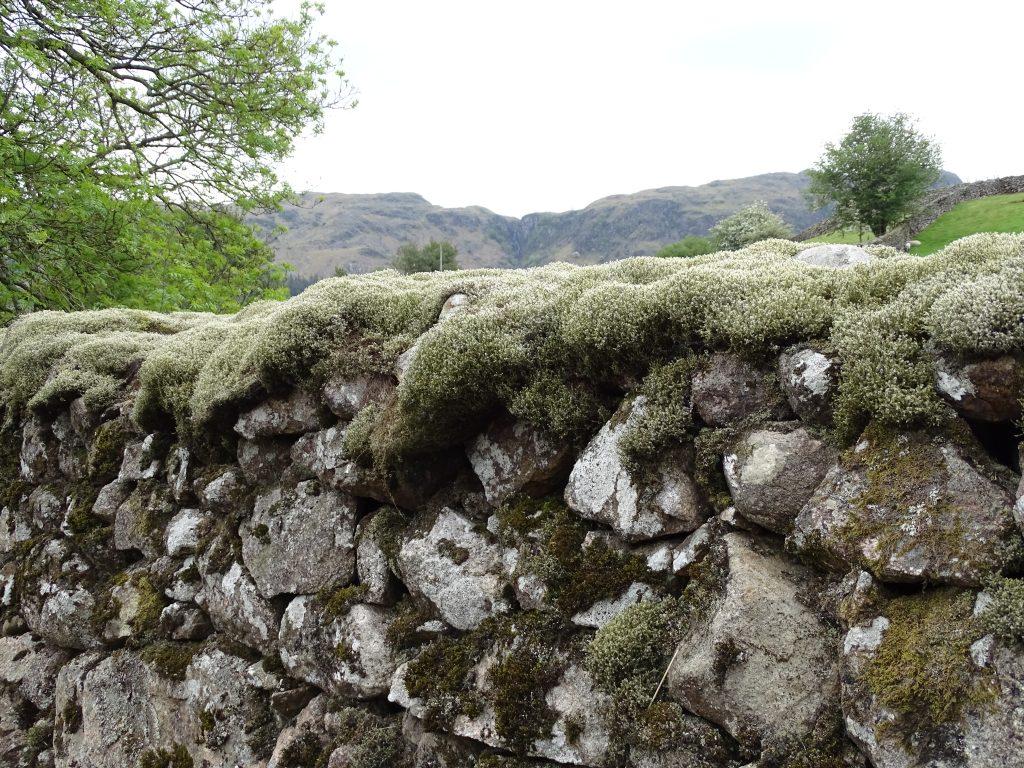

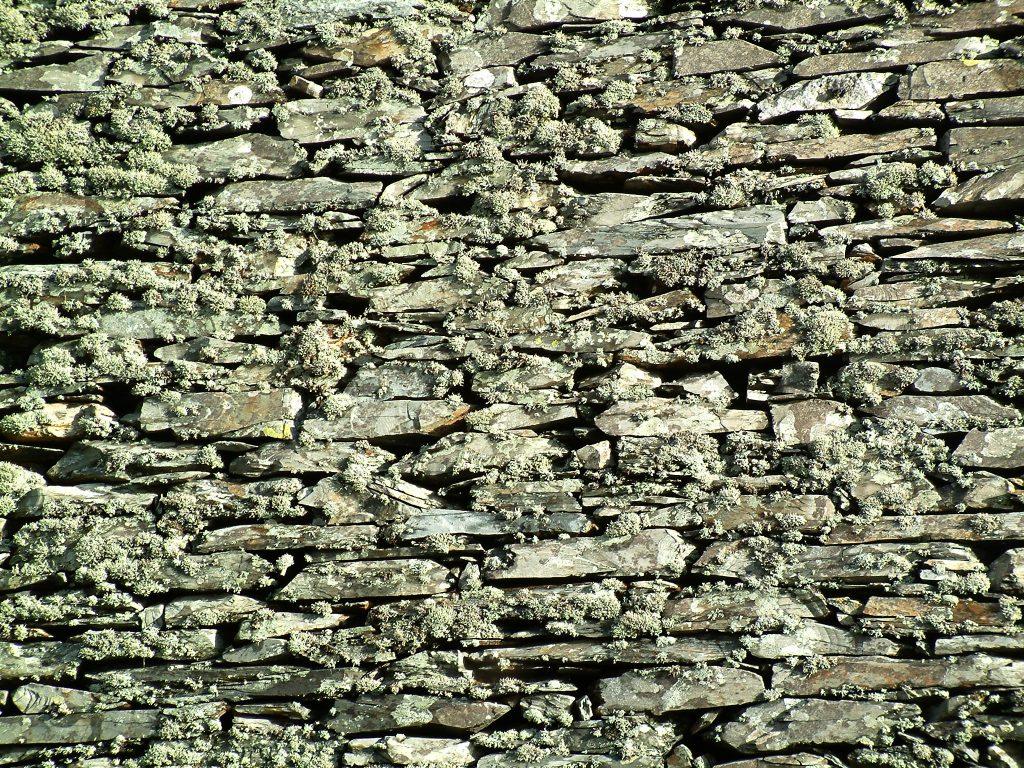

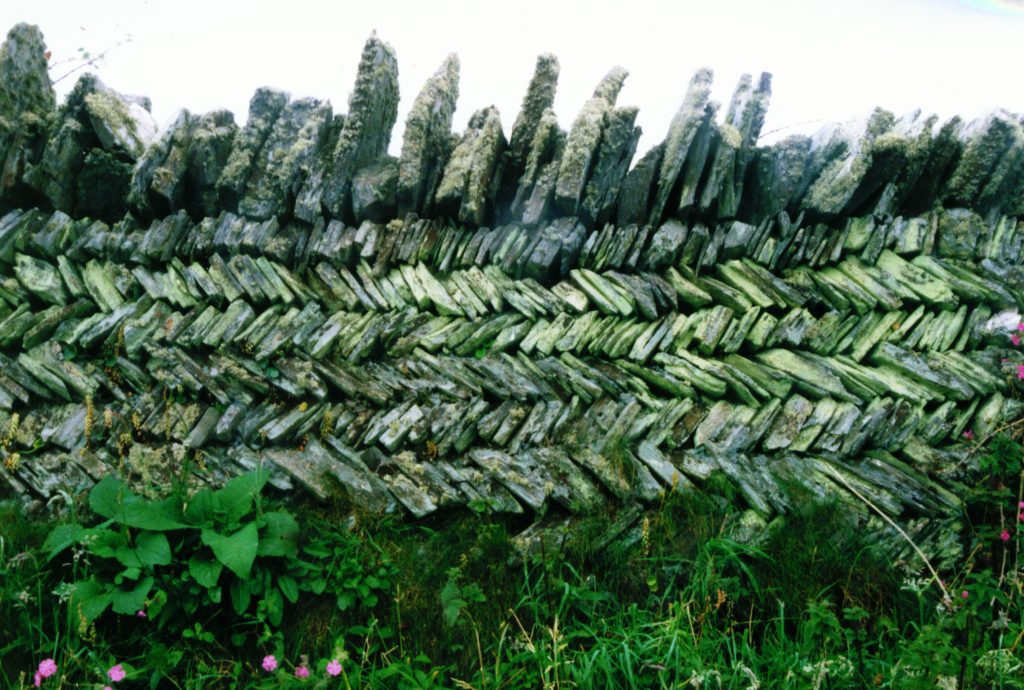
These initial colonisers in turn provide a foothold for flowering plants as small pockets of nutrient poor soil develop in and on them and between other stones. Most notably in the top of the wall, and particularly in retaining walls/terraces and also partly dependant on their position relative to the predominant weather direction, and surrounding vegetation. Woodland walls are usually more shaded and damp, coastal and upland walls can be severely desiccated on the seaward side whilst a relative haven on the side sheltered from the predominant elements.
Below on a stone wall near Newmill, Cornwall we have a common site on many western British walls described by Sarah carter as a mini rock garden,2 with Sedum Anglicum (English Stonecrop), mosses and lichens established amongst the top stones, described by the Cornish Hedges Library as “typical scree plants growing on top of a stone hedge” (in Cornwall walls are called hedges) near Newmill.3
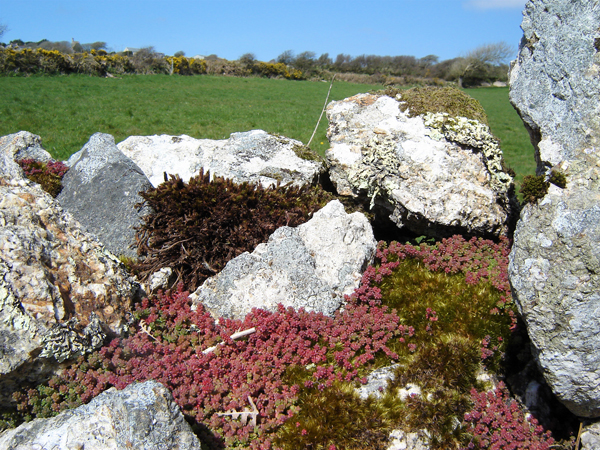
Technically (maybe pedantically), all Sedums are stonecrops – plants that can grow in very dry conditions partly because their small, thick leaves are particularly good at storing water and reducing transpiration (water loss), that is enabling them to ‘crop’ on ‘stone’
The ‘English’ part of this plant’s name is perhaps more of a misnomer, perhaps Western British might be better – it is certainly one of the most common plants found on Welsh walls. Another plant often found on walls (especially retaining walls with a shady aspect) are Umbilicaria commonly known as navelwort.

Above a fine specimen has rooted on the mosses growing between the stones of a wall, a great illustration of succession. ‘Wort’ is often attached to a plant thought, in the old physic, to have medicinal qualities. Sometimes the shape of the leaf or flower (such as lungwort) were thought to indicate where it would be of use. Others such as feverwort, just with whatever ailment it was used to treat. Navelwort has a round leaf with a depression in its centre is seen to resemble a navel. It was amongst other things used to treat a new born babies’ umbilical cord; however, it was more generally used for coughs, skin, stomach and kidney complaints. More prosaically it has another common name, perhaps more befitting its predominant habitat – “wall pennywort”. Interestingly modern research suggests that its leaves do contain good antioxidant and anti-inflammatory properties.
The unpronounceable and unremarked upon bryophytes give rise to the unnoticed, and for some unmentionable – snails, insects, and spiders shelter or live within them and the nooks and crannies. In turn they are valuable food sources for opportunistic small birds and mammals, and the less opportunistic who take up residence. Mice make homes, whilst passing flycatchers feast. As a food source the use of walls is not confined to birds and small mammals, much larger mammals have been known to exploit them too. During the siege of Malta during the Second World War many walls were severely damaged as food shortages led to the locals scavenging for whatever they could find. Snails are a rich source of protein!
Homes for nature across the UK landscape
Small holes can provide roosts for bats, gaps in the base an entranceway for weasels to take shelter, or hunt, maybe even nest, whilst toads love the cool damp bases of walls. Rarely does a waller dismantle any significant length of wall without unearthing at least one toad.
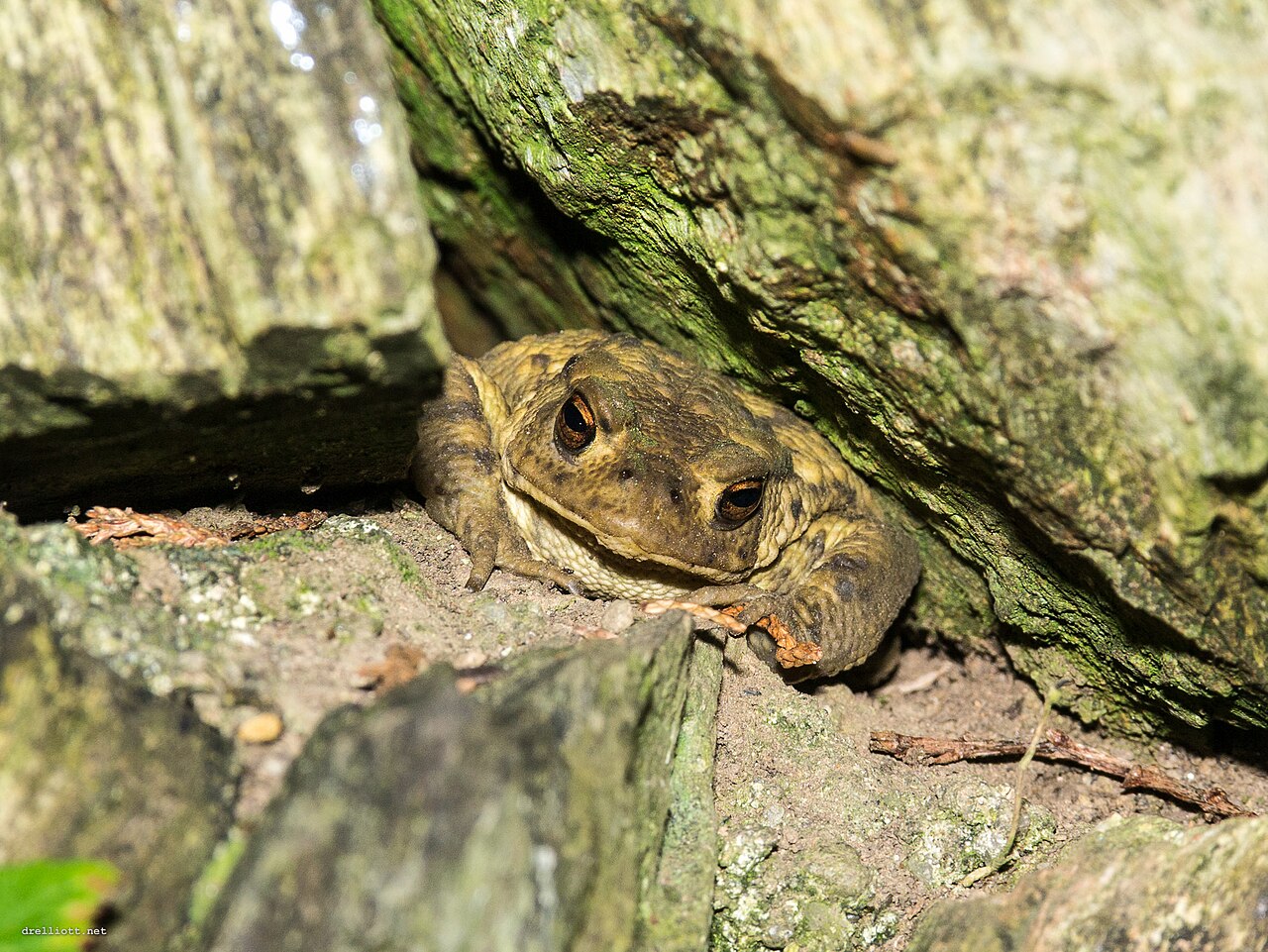
High on a hillside on the Carneddau, whilst dismantling a wall hundreds of yards from the nearest watercourse, I was more than a little taken aback by a tiny 1 or 2 cm froglet jumping out. I admit to screaming, however far more startling and accompanied by a far more impressive scream was the unearthing of a family of baby rabbits, in a derelict wall! Cute looking on reflection but, I can assure you, very rat-like when unexpected.
From wayward frogs and killer bunnies, to birdlife. Where in an otherwise largely featureless upland farm would you really expect to find wrens – “troglodytes troglodytes”, the cave dweller – other than flitting in and out of these man-made ‘caves’?


What could be more natural than a stonechat calling from a wall top? Whilst in open expanses walls provide perching post for birds of prey to eat their kill, little owls are even known to nest in them.

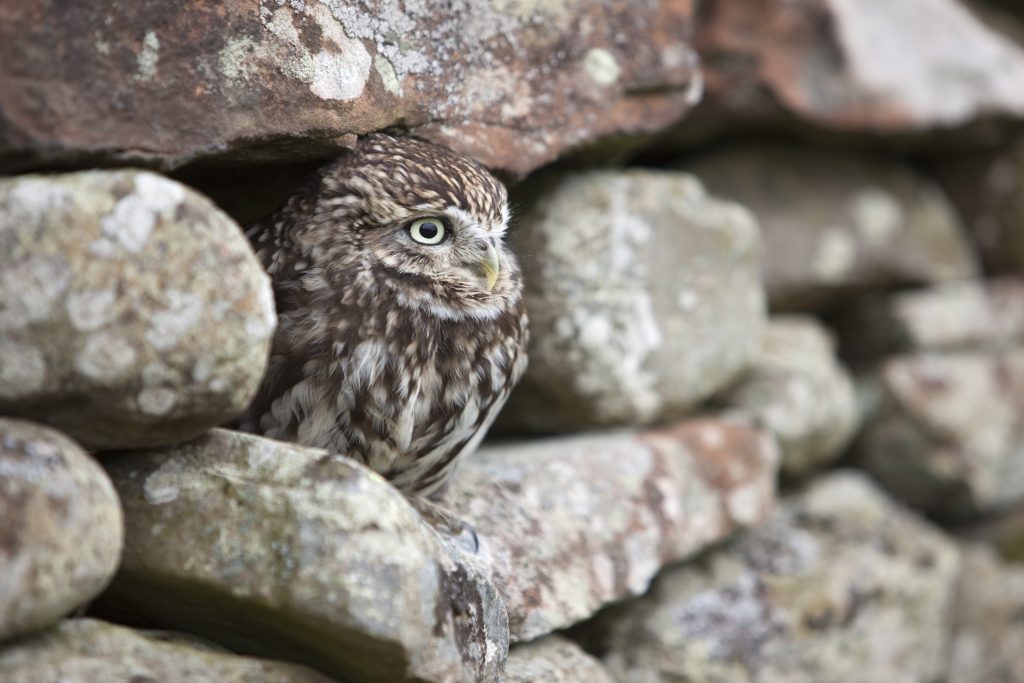
Small islands are a haven for birds, often free from rats and largely free from human interference, other than the passing tourists. Walls are often a haven within this haven. On Bardsey Island off the Llŷn peninsula in North Wales, Manx shearwaters and puffins nest in the core of old cloddiau, (stone faced earth banks), whilst on the world heritage site of Skellig Michael off Eire’s Kerry coast I once spotted a shy puffin peering out of a gap in the stone face of a retaining wall, its burrow presumably in the bank behind, whilst others sat atop low walls nearby watching small boats disgorge hundreds of tourists visiting the island each day.


700 ish steps, and 180 metres higher up, sits a 7th century dry-stone built monastery, the main objective of most of the tourists’ ‘pilgrimage’. The stonework of the monastery’s beehive huts no longer provides a home for monks, the main inhabitants now are shy and elusive storm petrels, coming home to roost when the tourists have gone home.

Storm petrels are just a sideline amongst the bird species of the Skelligs, whereas on Mousa island just off the southeast coat of Shetland’s Mainland, 8% of the British population and 2.6% of the world population nest.4
Many of the nests/burrows here can be found at sea level amongst the stones on the beach and in the nearby stone walls. Alongside one beach colony stands a 13-metre-tall iron age Broch, the most complete of Scotland’s dry stone Brochs – dry stone towers built for accommodation and/or defence around 2000 years ago.
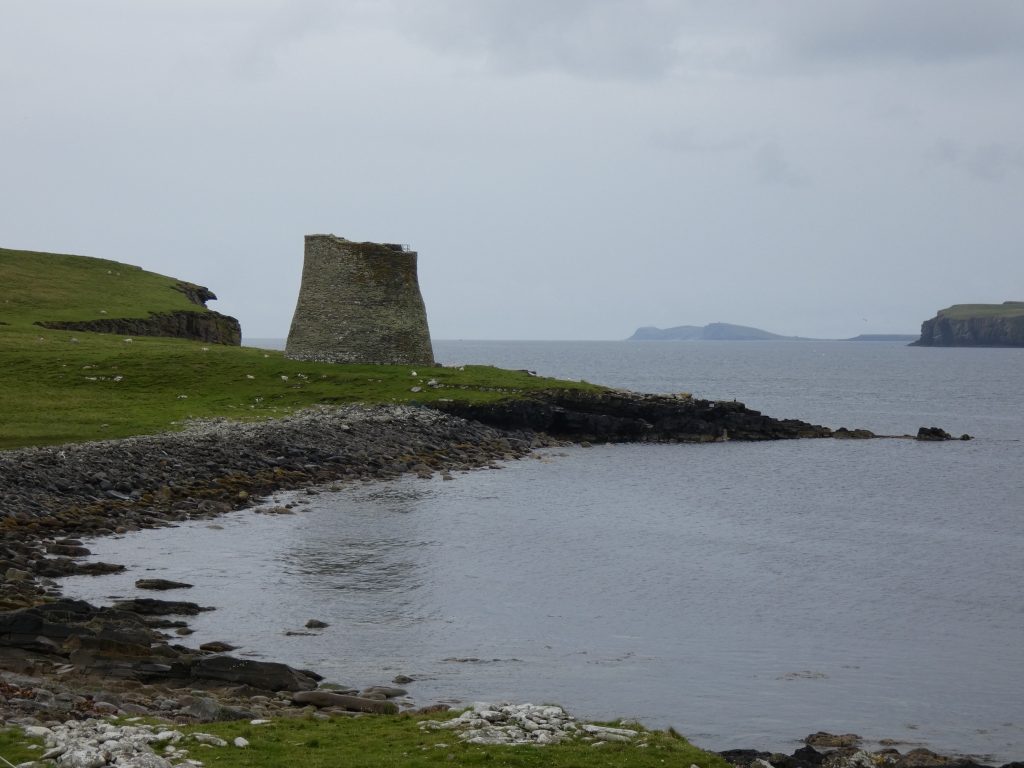
The Broch of Mousa is more or less still intact (with a little help from the Victorians) today. Like Skellig’s beehives, now its only permanent inhabitants are those storm petrels who seem to prefer high rise penthouse living compared to their bungalow dwelling neighbours.
On Skokholm island (southwest Wales) storm petrels have even had an artificial housing estate built for them. The Broch of Mousa and walls per se are not exactly natural and their suitability for wildlife is ‘merely’ a by-product of structure and age, basically stone structures are rarely built purely for wildlife. On Skokholm we have an exception, with two walls that have been christened “Petrel Stations”. Walls of specially fabricated concrete nest boxes have been clad with stone (dry stone face, mortar behind). The nesting habits of storm petrels have been particularly difficult to study, and the multi-storey nest boxes provide the petrels with plenty of choice for a nest and facilitate monitoring, some of the boxes even have cameras installed.5
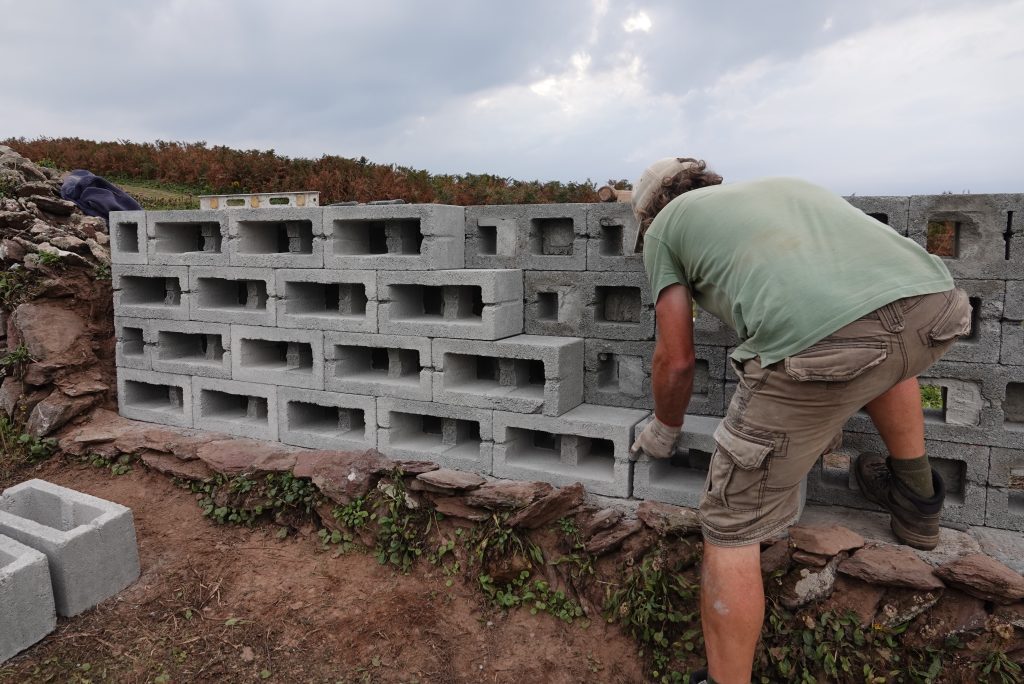

Copyright Richard Brown and Gisele Eagle
Microclimates and wildlife
I have already hinted at microclimates within walls in relation to their surrounding vegetation and the weather. In winter the centres of dry-stone walls are relatively warm and sometimes the home to hibernating reptiles. Whilst at the height of summer the slowworms, lizards and even adders, love basking on the heated stone on top, or on the south facing sides of walls. I once lifted a slab coping stone off a retaining wall to find a family of young slow worms – apparently somewhat less alarming than baby rabbits. The same cannot be said for the time that returning after lunch on a friends’ smallholding, to select a barrow full of stone from a pile of salvaged stone, an Amazonian python slithered off. Later research suggest it was a normal sized grass snake… I am not entirely convinced.
Whilst repairing one of the very tall terraces of “Opus 40” in New York State – one of the first examples of land art built in USA, snakes abounded swimming across ponds, winding startled from stone piles or just watching us work from between the stones of one of the many of the retaining walls. I was assured they were non-poisonous; I didn’t investigate further.

Getting back to the UK I have had limited contact with our one poisonous snake – the adder. My first encounter came over 40 years ago whilst carrying out a botanical survey of a heathland in Hampshire, before I had discovered walls. Merrily flinging a quadrat around ‘randomly’ I came across a curled-up adder unperturbed by my stumbling around. Back then I was younger, braver, more reckless perhaps, and photographed it with a standard 50mm lens. 30 years ago, a walling related adder incident more or less passed me by at a walling competition in North Wales. I was near one end of a long row of competitors, 40 metres or so away another competitor was bitten by an adder. I was concentrating hard on trying to win and the incident hardly registered. I’m not 100% sure I’m not imagining it now. The single-minded concentration didn’t do me any good, I lost by half a point. 30 years on it doesn’t rankle, I’m well over it, honest. Can’t be sure about the snake, certain about the half point.
Heathlands
Returning to heathlands. Last year I was repairing a wall as part of a heathland restoration scheme on Holyhead Mountain. Just above Mynydd Pentre (Mountain village) is a system of small fields known as “quillets” a word of French derivation, one theory being the initial works were carried out by quarrymen from the Channel Islands. As grazing regimes have changed over time (in this instance stock has almost completely disappeared) the walls have become derelict, and the fields covered with dense bramble and bracken. Here we can see another aspect of walls’ contribution to wildlife diversity within our landscape as much of our plant life and wildlife has developed alongside humankinds’ management of the countryside, particularly grazing. Remove or neglect the grazing and the land changes perhaps reverting ultimately to woodland (trees are indeed slowly spreading within the brambles, protected from the reduce grazing by dense clumps of bramble) – whether this is good or bad is a can of worms. In general terms walls contribute to this landscape and nature management and hence our landscape diversity. Within themselves they certainly contribute more than a post and wire fence.
Back on Holyhead Mountain. Here the heathland has been over-run by bracken and the walls are being repaired as part of re-instating a grazing regime. A 3m strip alongside the wall had been cleared of bracken to facilitate wall repairs. On dismantling the wall, I lined the coping at the very edge of the cut area alongside the bracken. One day strolling along the cut area beyond my repair, some yards in front of me an adder crossed my path. From that point on I made sure my stumbling around was noisy and several stones were tossed towards the coping whenever I headed towards them. The general advice is they’re more scared of you than you are of them (unlike baby rabbits?) and if they see or hear you coming will quickly disappear. I wonder what I would have done had any been as stoic as the one I had encountered 40 years before.
The waller in me is relieved I’ve not had a ‘hands on’ encounter as close as my first. However, the conservationist buried within is more than a little jealous of Mike Wynne Powell. He had come across a pair of adders, male and female, on top of a wall on one of his regular nature walks. His luck in he began watching and photographing them. After mating, the male stays to guard ‘his’ female, if another male arrives, they rear up and entwine their bodies in what is known as ‘the dance’ with the ‘protector’ trying to wrestle his rival to the ground and drive him away.

Sure enough, he noticed another male advancing along the wall. On arriving it immediately went to the male already there. They both rose up and twisted around each other and almost immediately fell of the wall, with the female falling off afterwards. Interloper vanquished the original male came back to find the female gone!
Factors of habitat diversity
A detailed survey of the walls of the Mendips carried out in 2008 showed that the biggest influence on the plant communities of the dry-stone walls were “wall height, width, light and moisture and substrate pH” [ie the local stone type], and that “Altitude and aspect had a significant but lesser influence”.6 Wall height and width were seen to be more important than location for plant diversity. The survey found species numbers decreased as wall height decreased but increased with wider walls and hence older semi-derelict walls were often the best habitat – more nooks and crannies and a greater accumulation of organic matter perhaps, newer walls/repairs were perhaps not surprisingly poorer habitats, as walls age its diversity improves, and whilst man made “it is undergoing many of the natural ecological processes that occur in nature and the habitat potentially is likely to hold and attain specialist ecological interest.” 7
It was also noted that there is a point where a derelict wall species diversity decreases, (other works suggest this begins below 600m8) presumably becoming increasingly poor it becomes overgrown/dominated by, for example, grasses and bramble.
Protecting the unique cultural heritage of dry stone walling
As inscriptions, walls are made up from the individual handwriting of scores of labourers, each subtly different. A record of the past punctuated by stiles and brought to a full stop by a gateway. They contain other terms to ponder; lunkies and smoots – passageways for sheep and water; coping and hearting – the top and the middle. Old walls meander lazily across fields, whilst those of the enclosure period urgently lice through the countryside and up mountainsides in rapier straight lines.
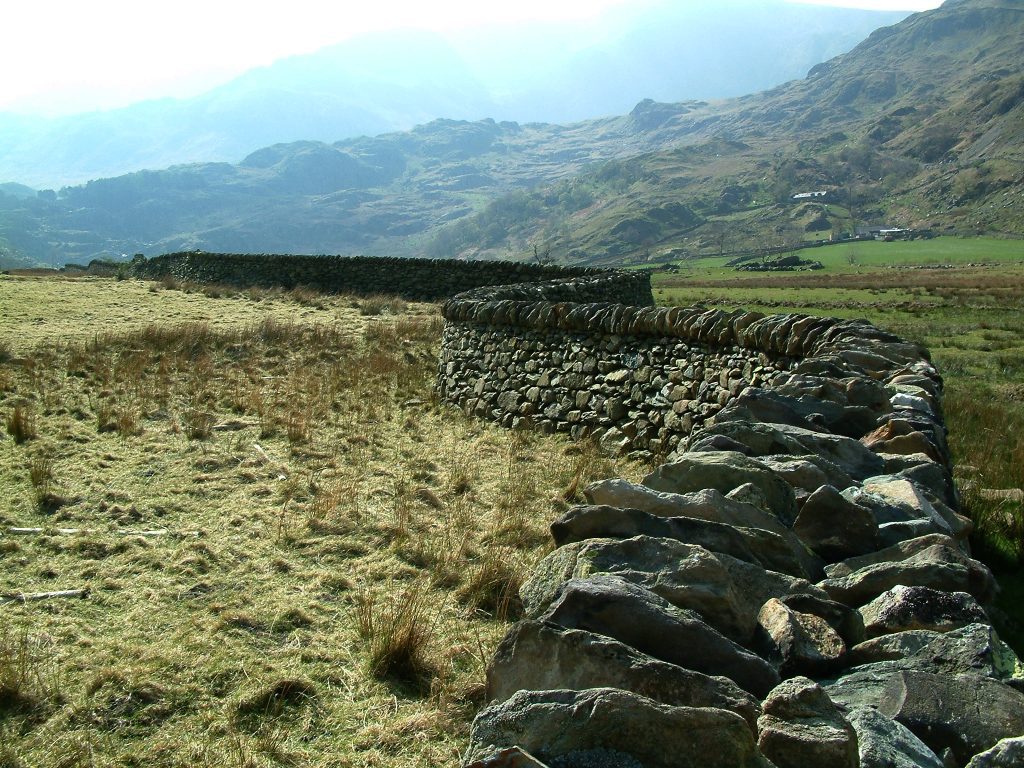
In areas alongside those where stone walls predominate but stone is scarcer, we often find stone faced earth banks. This is particularly true of the western coastal plain of south and mid-Wales, and the Llyn peninsula and Anglesey in the north. Less commonly they can also be found in Cumbria and parts of western Scotland and the highland isles. In Cornwall “Cornish Hedges” dominate the landscape much as dry stone walls do elsewhere. These structures – combining stone, soil and hedge, sometimes with an associated ditch alongside are mini nature reserves in their own right, a story for another day.
Many of these walls are approaching the end of their effective life spans, often uncared for, unmaintained. Additionally punctuated by gaps and collapses. Governments come and go, as do fashions for grants and funding. The walls remain, winding apparently endlessly across the landscape. But they cannot wind endlessly through history, they have a finite existence and now they collapse faster than they are repaired. In 1996 a survey estimated that there were 112,600 km of dry-stone walls in England, of which only an estimated 13% were in perfect order or needing minor repairs. Nearly 50% were no longer stockproof, and in some areas not far short of half existed only as remnants, with 17% of the total stock in this state.9. Whilst at least to some extent nature prefers older semi-derelict walls, this phase is generally a relatively short one, walls tend to deteriorate relatively quickly once they start to collapse, and their habitat value is markedly diminished once they have completely collapsed.
Each component of the countryside has in some way a statement to make, and the whole is diminished if any part is neglected. Just as you cannot magically create mature woodland you cannot conjure up an old wall, and to ensure that there are plenty of older walls in future we need to look after those that we have now.
“And this our life, exempt from public haunt; Finds tongues in trees, books in the running brooks; Sermons in stones, and good in everything.” (Shakespeare “As You Like It” Act II scene i).
This article is an adapted and a much expanded version of ‘Sermons in Stone’ an article published in “Network News” July 201210 .
Glossary
1 The term “Inscriptions upon the landscape” is borrowed from Geoffrey Grigson, who uses it to describe footpaths in Freedom of the Parish
2 Wildlife and The Cornish Hedge © Sarah Carter 2007. Revised 2023. P.4 extracted 27.08.24
3 see Cornish Hedges then Cornish hedge flora/dry hedge extracted 27.08.24
4 figures taken from North Link Ferries extracted 27.08.24
5 for further details see BTO Spring Issue 2 2024 and x.com/skokholm
6 Ecological Report – Lifelines Dry Stone Wall Survey Mendip Hills AONB. For Mendip Hills AONB Service. Betts Ecology 2008. p.31
7 Betts 2008 p.42
8 for example: Sustainability Exchange extracted 27.08.24
9 Countryside Commission. The Condition of England’s Dry Stone Walls. 1996
10 the original article can be seen via Dry-Stone or directly here.
About the Author
Whilst at university in the early 1980s, Sean had attended a few 10 day residential projects run by the then BTCV and was a member of Hampshire Conservation Volunteers. On graduating in 1982, he headed for a gap year in North Wales working as a ‘long term volunteer’ in the then BTCV centre in Llanberis. 40 years on he’s migrated 4 miles and become a Dry Stone Walling Association Master Craftsman spending most days stood at the side of a field piling stones in the rain. He regularly talks and writes about all aspects of a craft which has taken him across Europe, South Korea, and around 15 trips to USA and Canada. In 1997-98 alongside Liz Agate he carried out a major re-write of the TCV’s “Dry Stone Walling”. In 2024 he was awarded the British Empire Medal by King Charles for services to dry stone walling. His writings can be found here and a potted version of his walling career here.
***All photos copyright of author unless otherwise attributed.




